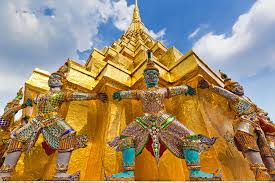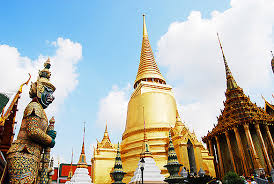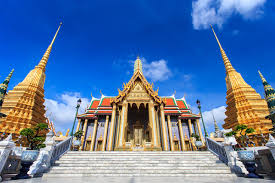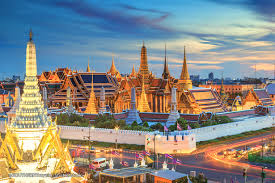Wat Phra Kaew or the Temple of the Emerald Buddha (officially known
as Wat Phra Sri Rattana Satsadaram) is regarded as the most important
Buddhist temple in Thailand. Located in the historic centre of Bangkok,
within the grounds of the Grand Palace, it enshrines Phra Kaew Morakot
(the Emerald Buddha), the highly revered Buddha image meticulously
carved from a single block of jade. The Emerald Buddha (Phra Putta Maha
Mani Ratana Patimakorn) is a Buddha image in the meditating position in
the style of the Lanna school of the north, dating from the 15th century
AD.

Wat Phra Kaew, Pronunciation, English: Temple of the Emerald Buddha:- full official name Wat Phra Si Rattana Satsadaram, is regarded as the most sacred Buddhist temple (wat) in Thailand. The Emerald Buddha housed in the temple is a potent religio-political symbol and the palladium (protective image) of Thai society.It is located in Phra Nakhon District, the historic centre of Bangkok, within the precincts of the Grand Palace.The main building is the central phra ubosot, which houses the statue of the Emerald Buddha. According to legend, this Buddha image originated in India where the sage Nagasena prophesized that the Emerald Buddha would bring "prosperity and pre-eminence to each country in which it resides", the Emerald Buddha deified in the Wat Phra Kaew is therefore deeply revered and venerated in Thailand as the protector of the country. Historical records however dates its finding to Chiang Rai in the 15th century where, after it was relocated a number of times, it was finally taken to Thailand in the 18th century.

It was enshrined in Bangkok at the Wat Phra Kaew temple in 1782 during
the reign of Phutthayotfa Chulalok, King Rama I (1782–1809). This marked
the beginning of the Chakri Dynasty of Thailand, whose current
sovereign is Vajiralongkorn, King Rama X.The Emerald Buddha, a dark
green statue, is in a standing form, about 66 centimetres (26 in) tall,
carved from a single jade stone ("emerald" in Thai means deep green
colour and not the specific stone). It is carved in the meditating
posture in the style of the Lanna school of the northern Thailand.
Except for the Thai King and, in his stead, the Crown Prince, no other
persons are allowed to touch the statue. The King changes the cloak
around the statue three times a year, corresponding to the summer,
winter, and rainy seasons, an important ritual performed to usher good
fortune to the country during each season.Wat Phra Kaew itself is the
main attraction though. This is Thailand's most important and sacred
temple, so you're expected to act with due respect inside it.
It
houses the tiny (between 60 and 75 cm) Emerald Buddha, which is located
high above the heads of the worshippers and tourists. Not much is known
for certain about the statue, except that it isn't actually made of
emerald but rather of green jade or jasper. Getting a good look at it is
difficult as photography is forbidden inside the temple, and it's
perched so high up inside it's glass box that it's difficult to see in
detail.It's thought to have been made in the 15th century and was the
cause of several wars before ending up for good in Bangkok in 1782. The
image is considered a talisman and holds tremendous significance for
Thailand and the Thais. The 'robe' that it wears is changed 3 times each
year by the King himself, at the start of each season: A diamond
encrusted gold robe during the hot season, a solid gold robe in the cool
season and a gilded monk's robe in the rainy season.There are also many
other Buddha images inside the temple.

History:-In 1767, the Kingdom of Ayutthaya fell to the Burmese, and King Taksin then moved the capital to Thonburi where he built the old palace beside Wat Arun on the west bank of Chao Phraya River. In 1778, Taksin's army under the command of Chao Phraya Chakri (who later became Rama I) captured Vientiane and took the Emerald Buddha back to Thonburi.In 1782, King Rama I succeeded to the throne and founded the Chakri Dynasty, and he decided to move the capital across the river to Bangkok as it would be better protected from attack.The site chosen for the palace is situated between two old wats, Wat Pho and Wat Mahathat, an area inhabited by Chinese residents who were then moved to the present Chinatown.He started the construction of the Grand Palace so that the palace may be ready for his coronation in 1785. Wat Phra Kaew, which has its own compound within the precinct of the palace, was built to house the Emerald Buddha, which is considered a sacred object that provides protection for the kingdom. Wat Phra Kaew was completed in 1784.The formal name of Wat Phra Kaeo is Phra Sri Rattana Satsadaram, which means "the residence of the Holy Jewel Buddha."Round the interior walls are murals depicting the jataka stories.

History:-In 1767, the Kingdom of Ayutthaya fell to the Burmese, and King Taksin then moved the capital to Thonburi where he built the old palace beside Wat Arun on the west bank of Chao Phraya River. In 1778, Taksin's army under the command of Chao Phraya Chakri (who later became Rama I) captured Vientiane and took the Emerald Buddha back to Thonburi.In 1782, King Rama I succeeded to the throne and founded the Chakri Dynasty, and he decided to move the capital across the river to Bangkok as it would be better protected from attack.The site chosen for the palace is situated between two old wats, Wat Pho and Wat Mahathat, an area inhabited by Chinese residents who were then moved to the present Chinatown.He started the construction of the Grand Palace so that the palace may be ready for his coronation in 1785. Wat Phra Kaew, which has its own compound within the precinct of the palace, was built to house the Emerald Buddha, which is considered a sacred object that provides protection for the kingdom. Wat Phra Kaew was completed in 1784.The formal name of Wat Phra Kaeo is Phra Sri Rattana Satsadaram, which means "the residence of the Holy Jewel Buddha."Round the interior walls are murals depicting the jataka stories.
These are located according
to the typical Thai conventions inside temples. The ones facing the
altar depict the victory of the Buddha over the evil demon Mara, as he
subdues her and achieves enlightenment. As is normal for Thai temples,
shoes must be taken off before entering into the temple.
Despite it's
national importance, Wat Phra Kaew is the only temple in Thailand that
doesn't have any resident monks, and so is not a seat of Buddhist
learning in the same way as the likes of Wat Pho and Wat Mahathat.Wat
Phra Kaew has undergone a number of renovations, restoration and
additions in its history, particularly during the reign of King Rama III
and Rama IV. Rama III started the renovations and rebuilding in 1831
for the 50th Anniversary of BangkoK of 1832, while Rama IV's restoration
was completed by Rama V in time for the Bangkok Centennial celebrations
in 1882. Further restoration was undertaken by Rama VII on Bangkok's
150th Anniversary in 1932, and by Rama IX for the 200th Anniversary in
1982.

Emerald Buddha:-It is not known when the statue of the Emerald Buddha was made, but it is generally believed that it was crafted in 14th-century Thailand.However, there are also claims that the statue originated in India or Sri Lanka.None of these theories can be firmly established as none of the historians could get a close look at the statue.According to one account, the Emerald Buddha was found in Chiang Rai, Lanna in 1434, after a lightning storm struck a temple. The Buddha statue fell down and later became chipped, and the monks, after removing the stucco around the statue, discovered that the image was a perfectly made Buddha image from a solid piece of green jade. The image was moved a few time to various temples, first to Lampang, then to Chiang Mai, from where it was removed by prince Chao Chaiyasetthathirat to Luang Prabang, when his father died and he ascended the throne of both Lanna and Lan Xang, in 1551. The statue remained the it to his new capital of Lan Xang in Vientiane in the 1560s.
The statue remained there for twelve
years. King Chaiyasetthathirat then shifted it to his new capital of Lan
Xang in Vientiane in the 1560s. He took the Emerald Buddha with him and
the image remained in Vientiane for 214 years until 1778.In the reign
of King Taksin, Chao Phya Chakri (who later became Rama I) defeated
Vientiane and moved the Emerald Buddha from Vientiane to Thonburi where
it was installed in a shrine close to Wat Arun. When Chao Phra Chakri
took over the throne and founded the Chakri Dynasty of the Rattanakosin
Kingdom, he shifted his capital across the river to its present location
in Bangkok. The Emerald Buddha was also moved across the river with
pomp and pageantry and installed in the temple of Wat Phra Keaw.
http://thailand2day.com/
No comments:
Post a Comment